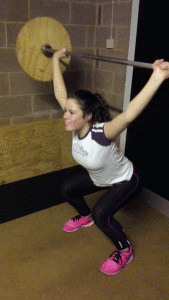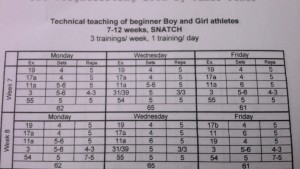Planning your Training: Periodisation for Young Athletes
What is Periodisation?
 Periodisation is the term given to the practice of breaking down an athlete’s conditioning plan into specific phases of training. Block periodisation is one version of this.
Periodisation is the term given to the practice of breaking down an athlete’s conditioning plan into specific phases of training. Block periodisation is one version of this.
By varying the emphasis of the training at regular time intervals, periodisation attempts to produce optimal gains in strength, power and endurance.
Periodisation aims to optimise both short term (e.g. weeks, months) and long term (e.g. years, over a career) goals. Competitive athletes will aim to peak their physical performance for major competitions on a weekly basis (e.g. Football, Rugby) or for a major competition (e.g. Athletics, Tennis).
Although young athletes are often competing in matches and tournaments, the goal should always be long term progression and periodisation should be devised to develop quality as well as quantity of physical performance.
The training variables that can be manipulated in an attempt to optimize the training program include:
- Volume of work done (e.g. sets and reps, number of sessions)
- Load (e.g. heavy or light resistance)
- Rest periods between exercises
- Types of exercises used (e.g. platform based exercises, multi-directional movements, technique based exercises).
Does periodisation work?
Despite the popularity of periodised training, there is little research examining its efficacy. A handful of studies have examined the effectiveness of a periodised resistance training programme on increasing strength and power.
Studies lasting between 6 and 24 weeks have repeatedly shown that athletes using programmes progressing from high volume and low intensity to low volume and high intensity increased strength (load lifted) and power (vertical jump/cycling force production) compared to constant training
intensity (1,2,3,4,5,6).
Interestingly, many of these studies showed that both groups increased strength in equal amounts up until the periodisation group began a phase of lower volume.
At this point the periodisation group began to see increases in strength significantly greater than the control group.
This supports the Delayed Transformation concept which suggests that a period of low volume is needed for optimum adaptation to take place.
One major limitation of these studies is the relatively short period over which they were conducted. Future research could investigate the longitudinal effects of periodisation to determine its efficacy for long term progression.
Does Periodisation Work for Young Athletes?
Periodisation for young athletes is difficult in practice. Many factors affect the ability of teenagers to attend training, not least school commitments and the increasing importance of academic achievement in society. Youngsters also rely heavily on parents for transport and funding coaching and equipment which could be barriers to regular participation.
Even on occasion when athletes are able to attend training, long school days (probably with inadequate nutrition and sleep) place a large amount strain on the body. This is not the best preparation for a training session possibly including heavy lifts or new complex techniques.
For this reason, flexibility within a training plan is vital, as is the ability of the coach to judge when to apply each exercise or training method.
Another consideration when coaching young athletes is the difference in growth and development rates (7). Individual’s rates of growth and maturation are largely unpredictable, thus making it hard to periodise a programme to peak at a specific time. This is also an important consideration when training groups of young athletes, as individuals will mature at different rates, making a progressive training programme difficult to plan.
In addition to this, periodising different phases of training may not even be necessary for a developing sportsperson. Young athletes have a high degree of neural plasticity and can therefore adapt to almost any training stimulus(8).
Even concurrently training competing physical qualities (such as maximal strength and anaerobic endurance) will result in a positive adaptation of both qualities to some extent.
Conclusion
Although Periodisation appears to be a valuable tool for maximising training of competitive athletes, rigidly sticking to a periodised plan is unrealistic for most developing athletes.
Numerous factors affect the ability of youngsters to train, affecting any opportunity to plan regular training. Physical and emotional stress of training and competing in different sports as well as juggling school work would mean adherence to a strict periodised plan could lead to overtraining and burnout.
Young athletes are also more able to adapt to multiple training stimuli, reducing the need for separate phases of training. Over time, however, as the athlete becomes better developed, training programmes should become more planned and focused.
Matt Durber
Periodisation for young athletes in practice.
- At our Athletic Development Club we apply some structure and planning to the teenage athletes, in conjunction with the other sports they play.
- For the younger athletes, we use a lot more guided discovery and never count sets or reps.
References
1) McGee, D., T.C. Jessee, M.H. Stone, & D. Blessing. (1992) Leg and hip endurance adaptations to three weight-training programs. J. Appl. Sport Sci. Res. 6:92–95.
2) O’Bryant, H.S., R. Byrd, & M.H. Stone. (1988) Cycle ergometer performance and maximum leg and hip strength adaptations to two different methods of weight-training. J. Appl. Sport Sci. Res. 2:27–30.
3) Stone, M.H., H. O’Bryant, & J. Garhammer. (1981) A hypothetical model for strength training. J. Sports Med. 21:342–351.
4) Stowers, T., J.McMillan, D. Scala, V. Davis, D. Wilson, & M. Stone. (1983) The short-term effects of three different strength–power training methods. Natl. Strength Cond. Assoc. J. 5:24–27.
5) Willoughby, D.S. (1992) A comparison of three selected weight training programs on the upper and lower body strength of trained males. Ann. J. Appl. Res. Coaching Athletics March:124–146.
6) Willoughby, D.S. (1993) The effects of meso-cycle-length weight training programs involving periodization and partially equated volumes on upper and lower body strength. J. Strength Cond. Res. 7:2–8.
7)Arsmtrong, N. & Welsman, J. () Training Young Athletes, In: Lee, M.J. eds. Coaching Children in Sport: Principles. pp191-203.
8) Brooks, T. (2011) Periodization for the young athlete. http://iyca.org/periodization-for-young-athletes. International Youth Conditioning Association.


Loved this. As stated children can literally outgrow your plans while other may appear not to develop but that just indicates huge latent potential. Don’t kill the goose that lays the golden egg with overtraining and remember talent is in the desire. John.
good blog
Very enjoyable read James, Mixed Training or Concentrated Loading….which one gets the greater DTE for youngsters… Opens the door for a long conversation.
Thanks Topsy.
[…] the idea of periodisation has been studied extensively, this final point of caution has only been addressed on a limited […]